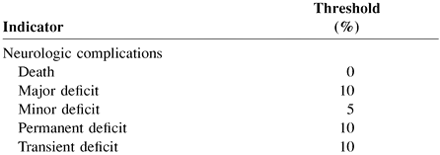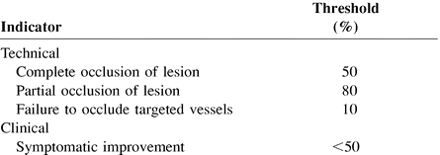Spinal Dural AVF
Indications
The presence of spinal dural AVF is an indication for treatment in all patients; embolization maybe contraindicated in those patients in whom the anterior spinal artery originates from the same pedicle as the spinal dural AVF.
Efficacy
Indicators:
The indicators of the efficacy of the endovascular management are technical and clinical success. Technical success is defined as occlusion of the targeted vessels. Clinical success is obliteration of the vascular malformation definitively or adjunctively or improvement or stabilization of symptoms.
Safety
Indicators:
When the following complications and corresponding thresholds are exceeded, a review should be conducted.
Spinal Cord AVMs
Indications
The indications for embolization of spinal cord AVMs include all symptomatic patients with lesions that can be cured; adjuvant therapy before surgery/radiosurgery; and palliative therapy when total obliteration is not practical and the patient suffers from progressive neurologic deficit or high risk of hemorrhage (associated aneurysm or pseudoaneurysm, previous hemorrhage) or when partial embolization is thought to be of benefit (presence of AVF, outflow restriction with venous ectasia).
Efficacy
Indicators:
The indicators of the efficacy of the endovascular management are technical and clinical success. Technical success is defined as occlusion of the targeted vessels. Clinical success is obliteration of the vascular malformation definitively or adjunctively or improvement or stabilization of symptoms.
Safety
Indicators:
When the following complications and corresponding thresholds are exceeded, a review should be conducted.
Perimedullary AVFs
Indications
The presence of a perimedullary AVF, even if clinically silent, is an indication for treatment. Embolization is indicated if sufficiently superselective catheterization can be performed; surgery may be the best therapeutic modality in cases of type 1 (smallest) perimedullary AVF.
Efficacy
Indicators:
The indicators of the efficacy of the endovascular management are technical and clinical success. Technical success is defined as occlusion of the targeted vessels. Clinical success is obliteration of the vascular malformation definitively or adjunctively or improvement or stabilization of symptoms.
Safety
Indicators:
When the following complications and corresponding thresholds are exceeded, a review should be conducted.
Epidural and Perispinal Vascular Malformations
Indications
Indications include adjunctive (preoperative) and/or palliative treatment when the patient suffers from neurologic or cardiac symptoms.
Efficacy
Indicators:
The indicators of the efficacy of the endovascular management are technical and clinical success. Technical success is defined as occlusion of the targeted vessels. Clinical success is obliteration of the vascular malformation definitively or adjunctively or improvement or stabilization of symptoms.
Safety
Indicators:
When the following complications and corresponding thresholds are exceeded, a review should be conducted.
Spinal Axis Tumor Embolization
Indications
The indications for embolization of hypervascular tumors of the spinal axis include decreasing surgical morbidity by reducing blood loss, shortening operative time, increasing the chance of complete resection, relieving intractable pain, reducing expected tumor recurrence, decreasing systemic toxicity of intra-arterial chemotherapy, stabilization of function, and sole treatment for a patient who is at poor risk for surgical therapy, radiation therapy, and/or chemotherapy.
The hypervascular tumor types for which embolization may be indicated include benign tumors (hemangiomas, aneurysmal bone cysts, osteoid osteomas, osteoblastomas, chondromas), malignant tumors (giant cell tumors, chordomas, osteogenic sarcomas, chondrosarcomas, hemangiopericytomas, lymphomas, multiple myelomas, plasmacytomas), metastatic tumors (renal cell carcinomas, thyroid carcinomas, other hypervascular metastases), and spinal cord tumors (hemangioblastomas).
Threshold:
When <95% of the procedures are performed for the above indication, a review should be conducted.
Efficacy
Indicators:
The indicators of the efficacy of the endovascular management are technical and clinical success. Technical success is defined as occlusion of the targeted vessels. Clinical success is decrease in expected blood loss during surgery or palliation of symptoms.
Safety
Indicators:
When the following complications and corresponding thresholds are exceeded, a review should be conducted.
Puncture site complications, allergic reactions to contrast media, and contrast media-induced nephropathy will be recorded in the angiography section.
- Copyright © American Society of Neuroradiology











